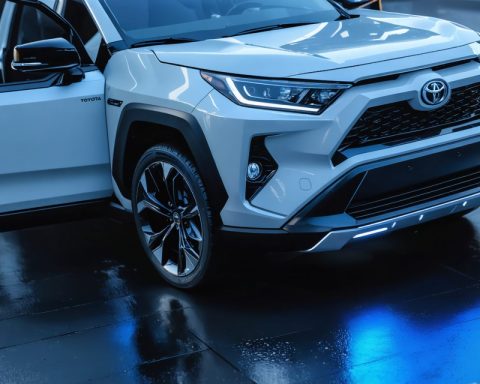- China and Europe are reigniting discussions on the electric vehicle (EV) anti-subsidy case, focusing on cooperation rather than conflict.
- Europe is concerned about China’s subsidies creating an uneven playing field for European automakers.
- China seeks to secure investments and foster mutual growth with European firms, aiming for shared industrial innovation.
- The discussions emphasize the importance of syncing regulatory and economic frameworks for sustainable collaboration.
- This negotiation underscores the need for diplomacy that prioritizes industrious collaboration over economic confrontation.
- The dialogue highlights the global push for sustainability, reinforcing that cooperation leads to progress towards an electrified future.
The stage is set in a brightly lit conference room, bathed in the quiet hum of anticipation. This is no ordinary gathering; it marks a crucial step in the intricate ballet between two economic powerhouses—China and Europe—as they navigate their roles in the global electric vehicle (EV) revolution.
In a move that signals the start of a significant dialogue, China’s Ministry of Commerce has announced a mutual agreement with its European counterparts to rekindle discussions on the contentious electric vehicle anti-subsidy case. Both parties are not just dusting off this old dossier—they are eager to infuse new life into it by forging pathways for cooperation rather than conflict.
The heart of the matter pulses with the rhythm of global commerce. Europe harbors concerns that China’s subsidies for its electric vehicle sector create an uneven playing field. European automakers, long used to the allure of longstanding tradition and engineering prowess, now find themselves grappling with the rapid ascension of Chinese EVs powered by vibrant state support.
Meanwhile, for China, the sun rises on a different horizon. The country aims to not only secure investments but also foster an environment of mutual growth with European firms. This symbiotic ambition offers a prism through which both regions can view industrial innovation—a shared vision for a sustainable future.
The drive to sync their regulatory and economic gears is more than just strategic posturing. It’s about cultivating a fertile ground for investment and industrial collaboration, breathing life into a future where electric vehicles do not merely transport individuals, but ideas and dreams across continents.
This negotiation is poised at the delicate intersection of ambition and pragmatism. It beckons each side to step beyond protectionist impulses and embrace a form of diplomacy that champions industrious collaboration over economic confrontation.
This isn’t just a corporate maneuver; it’s a narrative that threads through the fabric of global sustainability efforts. As they dance around the negotiating table, China and Europe exemplify the energy of a world striving for greener pastures, proving once again that the road to progress is paved with dialogue and mutual understanding.
In the end, the takeaway is as clear as a sunlit boulevard: cooperation trumps conflict, and through sustained dialogue, both regions can accelerate towards an electrified future. This unfolding narrative asks us all to think bigger, to dream beyond borders, and turn the wheel towards an era defined by innovation and collaboration.
Will China and Europe Transform Global EV Markets Through Renewed Cooperation?
Introduction
The recent announcement of rekindled discussions between China and Europe represents a significant development in the global electric vehicle (EV) landscape. Both regions are committed to moving past previous controversies concerning China’s EV subsidies. As they embark on this path, there is more than just an economic narrative at play—there is potential for global leadership in sustainable innovation.
Key Facts and Insights
Market Forecasts & Industry Trends
– Europe’s EV Market Growth: Europe is quickly transforming into one of the world’s leading EV markets, buoyed by stringent CO2 emission targets and increasing consumer demand. The European Automobile Manufacturers Association (ACEA) predicts continued robust growth, driven by government incentives and expanding charging infrastructure.
– China’s EV Prowess: China is the largest global market for electric cars, thanks to aggressive government policies and consumer interest in low-emission alternatives. Its “Made in China 2025” initiative underscores a strategic focus on becoming a world leader in high-tech industries, including electric vehicles.
– Potential Synergies: Cooperation between China and Europe could lead to shared advancements in battery technology, charging infrastructure, and environmental standards, potentially reducing costs and enhancing innovation globally.
How-To Steps & Life Hacks
– Navigating EV Purchases in a Global Market: When buying an EV, assess subsidies available in your country, factor in the long-term savings from reduced fuel costs, and consider the availability of charging stations in your area.
Controversies & Limitations
– Subsidy Disputes: European automakers have expressed concerns that Chinese state subsidies provide an unfair advantage, allowing Chinese EV manufacturers to offer lower prices in European markets. This issue underscores the need for transparent and equitable trade practices.
– Technological Dependence: Europe may face potential risks related to over-reliance on Chinese technology for EV batteries and other components, highlighting the importance of diversifying supply chains.
Features, Specs & Pricing
– Comparative Analysis: European brands like Volkswagen and Renault compete with Chinese brands such as BYD and NIO, each offering a range of vehicles varying in price, technology, and performance. Consumers should consider factors like battery range, pricing, and brand reputation.
Security & Sustainability
– Green Innovation: A cooperative approach will likely result in joint development initiatives aimed at reducing the environmental impact of manufacturing and increase the recyclability of EV components.
Pros & Cons Overview
Pros:
– Enhanced technological development through shared research and innovation.
– Potentially lowered costs due to combined economies of scale.
– Acceleration of infrastructure development and standardization.
Cons:
– Risk of geopolitical tensions impacting trade negotiations.
– Market competition could pressure local manufacturers and affect employment.
Actionable Recommendations
– Stakeholder Engagement: Governments and corporations should foster open lines of communication, ensuring that policy developments benefit all parties involved.
– Consumer Education: Awareness campaigns to educate consumers on the benefits and costs of EVs can facilitate smoother market transitions.
– Sustainability Commitments: Continued commitment to sustainability is crucial. Both regions should prioritize the environmental impact of their policies and practices.
Conclusion
The collaboration between China and Europe in the electric vehicle sector could be a game-changer. By prioritizing cooperative innovation over competition, both regions have the opportunity to set new benchmarks for sustainability and technological advancement. As negotiations continue, stakeholders worldwide will be watching closely to see if this partnership can dynamically reshape the future of the global EV market.
For more insights into global economic collaborations, visit European Commission’s website.















